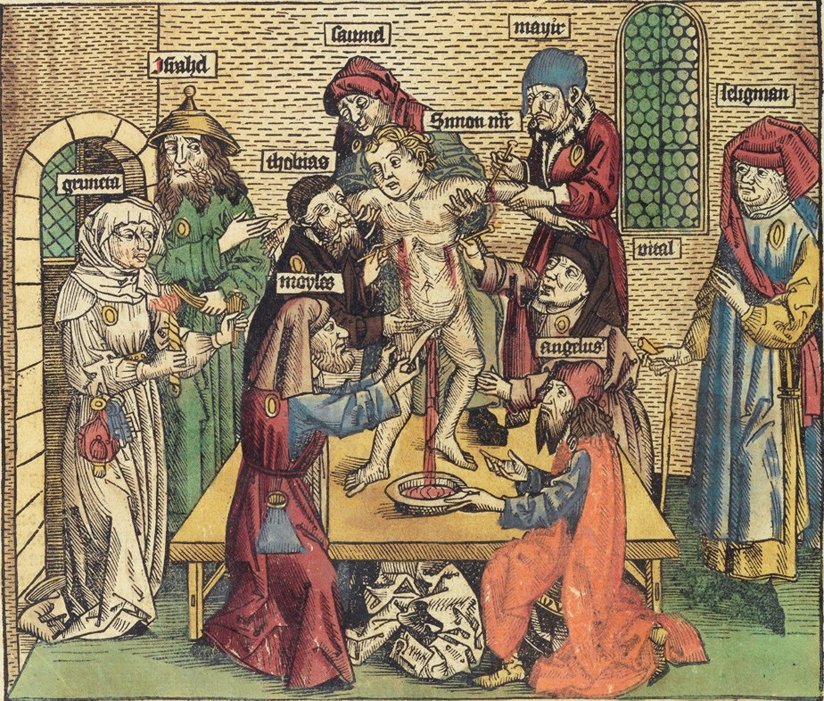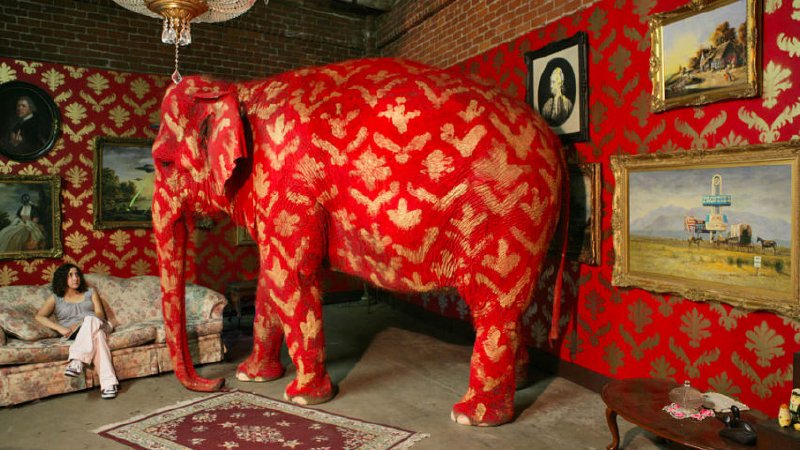Anti-Semitism 101, Part 1: The Roots of the Movement
This is the first installment of a series on how bigotry against specific groups began. The label, “101,” is a disclaimer. There’s no attempt at anything comprehensive here. These articles are a basic, broad-brushed historic sketch of the roots of these prejudices and their ensuing growth, in order to bring about an understanding of antipathy toward certain groups, and hopefully, of bigotry in general.
Mistrust, suspicion, exclusion and their allied feelings are the sparks given off from the sticks of ignorance and fear when they are rubbed together to produce the flame of hate. Sense, logic, intelligence have nothing to do with the spreading of hate, much as reason and sanity play no part in the spreading of a wildfire. Gullibility does play a large part, along with the desire for someone to blame for one’s misfortunes. Yet despite hatred’s need of our baser emotions, its first seeds are often sewn with methodical craft and planning, with the protection or survival of a certain clique in mind.
We hope the reader is encouraged, on reading these articles, to do his or her own research for a deeper understanding of this cultural cancer in our midst.
Our first subject is anti-Semitism.
Newly released FBI data showed a 37 percent increase in anti-Semitic attacks, the largest single spike in decades, with the recent shooting at a Pittsburgh synagogue being the deadliest anti-Semitic hate crime on American soil, prompting Anti-Defamation League CEO and Director Jonathan Greenblatt to comment, “More must be done to address the divisive climate of hate in America. That begins with leaders from all walks of life and from all sectors of society forcefully condemning anti-Semitism, bigotry, and hate whenever it occurs.”
The term “anti-Semitism” was first popularized by German publicist and agitator, Wilhelm Marr in 1881. It means: “hostility to, prejudice or discrimination against Jews.”
“Semitic” means “a person who speaks any of a family of languages, including Hebrew, Arabic, or any related ancient language.” The derivation is “Shem,” the eldest son of Noah in the Bible, from whom these people were traditionally supposed to be descended. “Anti-Semite” and “anti-Semitic,” however, are words specifically describing the targeting of Jews.

Judaism’s great gift to the world was the idea of a single, omnipotent, omniscient and righteous God, with whom one could have a personal relationship. Such a concept—circa 2100 BCE, when Jews made their entry in history as a small nomadic tribe in the region called Ur in modern Iraq—was radical, to say the least, and set Jews apart from the other ancients whose concepts of divinity were a range of amoral gods, who were (either as household icons or as lofty super-beings dwelling on high) largely indifferent or worse, sadistic, toward the affairs of humans.
As Huston Smith writes, in The Religions of Man, “Whereas the gods of Olympus tirelessly pursued beautiful women, the God of Sinai watches over widows and orphans. While Mesopotamia’s Anu and Canaan’s El were going their aloof ways, Yahweh is speaking the name of Abraham, lifting his people out of slavery… God is a God of righteousness whose loving kindness is from everlasting to everlasting and whose tender mercies are all over his works.”
From that suspicion grew hatred, and tens of thousand of Jews were burned for a crime they had not committed.
The Jews, then, were set apart in the ancient world, a factor that worked both for them—preserving a unique and imperishable identity—and against them, making them stand out as “different,” and hence a people to be watched closely and suspiciously.
Because the Hebraic peoples engaged in conquest, defeat and counter-conquest, as did so many other vying cultures and city-states in ancient times, pinpointing an exact date for the beginning of anti-Semitism, as an actual mindset of prejudice against Jews (as opposed to simply wanting to conquer and pillage them) is difficult.
We can, however, safely start with King Antiochus IV of Syria, who, in the 160s BCE, might be considered the first anti-Semite. A fervent Hellenist (a person who wants to follow the culture of the ancient Greeks) who hated all things non-Greek, he made it his mission to bring what he saw to be the civilizing culture of Greece throughout his empire. The Jews, as nonconformists, were his primary target.
The Jews were at odds with the wave of Hellenism spreading through the Middle East. They regarded the pagan multi-god religion of Hellenism as a throwback to the old idols worshipped by their predecessors, and they certainly refused to bow to Antiochus who enforced his own godhood on them by law. They clung, stubbornly, most of them, to their religion of revelation, of a transcendent, unseen-but-felt God, and a world order based on righteousness, not on greed and whim. Antiochus retaliated, first by banning all Jewish observances, including circumcision (the physical rite that confirmed the Jews as “different” from others) and finally by invading Jerusalem, plundering the Temple and rededicating it on December 25, 167 BCE to the Olympian god, Zeus.
This impious act was too much, and the Jews—led by Mattathius, a local priest, and his five sons, otherwise known as the Maccabees—rebelled against the Syrians, and after three years drove them out, rededicating the Temple on the 25th of the Hebrew month of Kislev, a date that forever after would be celebrated by Jews as “Chanukah,” which literally means “dedication.”

The idea that Jews were somehow “different” became more of a problem for non-Jews as the centuries passed. In the early years of the Christian Era, Jews were regarded as God’s chosen people and thus sacred, whether they converted to Christianity or not. But as more Roman emperors became Christian, Jews were increasingly marginalized for their refusal to accept Jesus Christ as the Messiah. Beginning in the 3rd century CE, Jews began to lose their rights, and discriminatory laws were passed forbidding them to marry Christians (399 CE) or to hold government positions (439 CE) or to appear as witnesses against Christians in court (531 CE).
Jews now were positioned as a threat. In addition to the repressive laws, rumors spread that Jews had horns and tails and that they killed Christian babies and used their blood for rituals.

In the Dark Ages, the differences and separation between Jews and non-Jews increased. In Europe, Jews were made to dress differently and to live separately from gentiles in communities that were to become known as “ghettos.” Again, difference bred suspicion. By the 11th century the Church taught that the Jews had killed Christ, a destructive canard that was not withdrawn until 1965 by the Second Vatican Council.
In the 14th century, the Black Plague annihilated one-third of the population of Europe. Jews, probably because they lived separate from everyone else, were largely not infected by the contagious disease. But, again, differences bred suspicion, and Jews were blamed for the Plague. They were in league with Satan, the story went, and secretly poisoned the wells of Christians at night. From that suspicion grew hatred, and tens of thousand of Jews were burned for a crime they had not committed.
In the early centuries of the last millennium, the Church forbade Jews from owning land, but allowed them to handle money, make loans and charge interest, and so many of them became tax collectors and money-lenders—job choices with little guarantee of popularity, but since Christians were forbidden from handling money at interest, the opportunity to make a living thereby was open to the Jewish community.
Thus came to pass the stereotype of “the greedy Jew,” as seen, for example, in Shakespeare’s Merchant of Venice, wherein Shylock, described by Shakespeare as “a miserly Jew; moneylender,” seeks to exact a pound of flesh from a merchant who has defaulted on a loan. Shylock is outwitted in the end, however, and made to convert to Christianity.
In 1492, the King of Spain decreed the expulsion of all non-converted Muslims and Jews from the country on pain of death.
Throughout Europe, from the Dark Ages through the Renaissance and the Reformation, Jews were a shunned, isolated minority. There was one European country, however, where Jews flourished and prospered for seven centuries: Spain.
From the 8th through the 14th centuries, Spain was the unquestioned leader of world Jewry. Jews distinguished themselves in the sciences, philosophy and literature during this period, and occasionally exerted influence as advisors to royalty. But the bubble burst abruptly in 1391 when a monk, Fernando Martinez, incited his followers to set fire to the Jewish quarter of Seville, killing 4,000 men, women and children. Thousands more died in the ensuing riots that broke out throughout Spain, leading nearly a quarter million Spanish Jews to convert to Catholicism out of self-preservation. These crypto-Jews, otherwise called Marranos (Spanish for “pigs,” after the Jewish prohibition of the eating of pork) largely practiced their faith in secret.
In 1492, the King of Spain decreed the expulsion of all non-converted Muslims and Jews from the country on pain of death. Nearly 500 years later, Holocaust survivor and scholar, Simon Wiesenthal, after years of research, determined that Columbus and his crew were quite possibly themselves Marrano Jews, and in his book, Sails of Hope, outlined his hypothesis that the voyage to the New World was actually a desperate search for a new Jewish homeland.
In the 16th century, the Protestant Reformation swept through Europe, exposing and expunging many of the excesses and corruption of the Catholic Church at the time. The Reformation’s chief architect, Germany’s Martin Luther, at first welcomed Jews into the fold of the new Christianity, but rapidly turned on them when they failed to embrace it.
His book, On The Jews and Their Lies, eloquently spewed the more popular venom on the Jews, describing them as “a base whoring people, that is, no people of God, and their boast of lineage, circumcision and law must be accounted as filth. They are full of the devil’s feces which they wallow in like swine… They are to be shown no mercy.” Luther went on, calling for the burning of synagogues and schools, the outlawing of Rabbinical teachings, confiscation of property, expulsion from Germany and—in a chilling foreshadowing of what was to come four centuries hence—extermination.
Aided by the newly-invented printing press, On The Jews and Their Lies became the first mass media “fake news.” Gutenberg’s brainchild had brought the world the twin capabilities of enlightening the planet with truth or plunging it into darkness with lies.
And for the Jewish people, it represented a ramping up of anti-Semitism to the nth degree.










